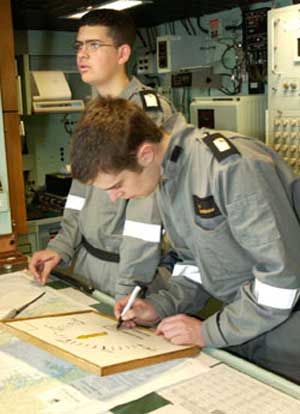Navy Hydrographic Survey Officer
Tasks & duties

Navy hydrographic survey officers may do some or all of the following:
-
decide where to have survey sites
-
set up and operate survey stations at sea and onshore
-
navigate survey motor boats safely in and around survey grounds
-
control the operations of survey motor boats such as lowering specialised equipment into the water
-
survey the seabed in and around New Zealand coastal waters and the Pacific
-
observe and interpret the collected survey data
-
analyse survey data and records
-
operate computer data processing systems
-
prepare detailed charts and reports
-
organise the ship's survey department
-
manage the careers of ratings (lower ranks)
Skills & knowledge
Navy hydrographic survey officers need to have:
-
knowledge of surveying methods
-
knowledge of land and sea features
-
knowledge of navigation
-
knowledge of how to use and care for survey equipment
-
knowledge of Royal NZ Navy regulations and safety procedures
-
technical and maths skills
-
skill in analysing and interpreting information
-
computer skills
-
planning skills
-
leadership skills and decision-making ability
-
good communication and writing skills
Entry requirements
To enter the Royal NZ Navy you must be at least 17 years old and eligible to be a New Zealand citizen. You need to pass a series of psychometric tests and an interview. You must then pass medical and fitness tests and meet an acceptable standard of eyesight and hearing. You also need to be given security clearance, so any criminal convictions you have will be looked at.
To become a navy hydrographic survey officer you need to have NCEA Level 3, including 80 credits over five subjects. You must have a minimum of 14 credits at Level 1 or above in maths, and a minimum of 14 credits at Level 2 or above in English, or School Certificate equivalent.
Navy hydrographic survey officers may join the Navy through the navy midshipman scheme (university) under which you are sponsored to complete a full-time degree, through the Navy midshipman scheme (non-university) under which you complete the majority of training on the job and are sponsored to take some university papers, or as a graduate.
Tertiary education
Navy hydrographic survey officers generally complete a Bachelor of Arts, a Bachelor of Science, or management studies.
The Royal NZ Navy sponsors suitable candidates through university or reimburses relevant study already completed. There are various sponsorship schemes available. If you are being sponsored to study full-time, you will be posted to a ship or shore establishment for on-the-job training during study breaks.
Training on the job
On-the-job training begins with a six -month Junior Officer Common Training Course (JOCT) at the Royal NZ Naval College. This course serves as a general introduction to the Royal NZ Navy and prepares you for general duties as a naval officer.
You then complete the Grade III Officer of the Watch (OOW) course where you learn the basics of coastal navigation, communications and bridge management. You are then posted to a ship to practise what you have learnt.
After this, navy hydrographic survey officers on the midshipman university scheme begin full-time study for three years, and those on the non-university scheme continue on-the-job training to achieve more advanced certification. Those on the university scheme work towards the same certificates after achieving their university degree. The NZ Maritime Safety Authority endorses these certificates.
Navy hydrographic survey officers also complete the officer's leadership development programme, which is taught in conjunction with the Auckland Polytechnic.
Useful experience
A regular fitness programme, involvement in youth organisations or team activities is useful experience. Sailing experience is also useful.
Related courses
Mapping Science
Surveying
For more information, please refer to Career Services.
Document Actions
